【实例简介】Data Structures and Algorithm Analysis in C 4th
本书是数据结构和算法分析的经典教材,书中使用主流的程序设计语言C 作为具体的实现语言。书中内容包括表、栈、队列、树、散列表、优先队列、排序、不相交集算法、图论算法、算法分析、算法设计、摊还分析、查找树算法、k-d树和配对堆等。本书把算法分析与C 程序的开发有机地结合起来,深入分析每种算法,内容全面、缜密严格,并细致讲解精心构造程序的方法。
【实例截图】
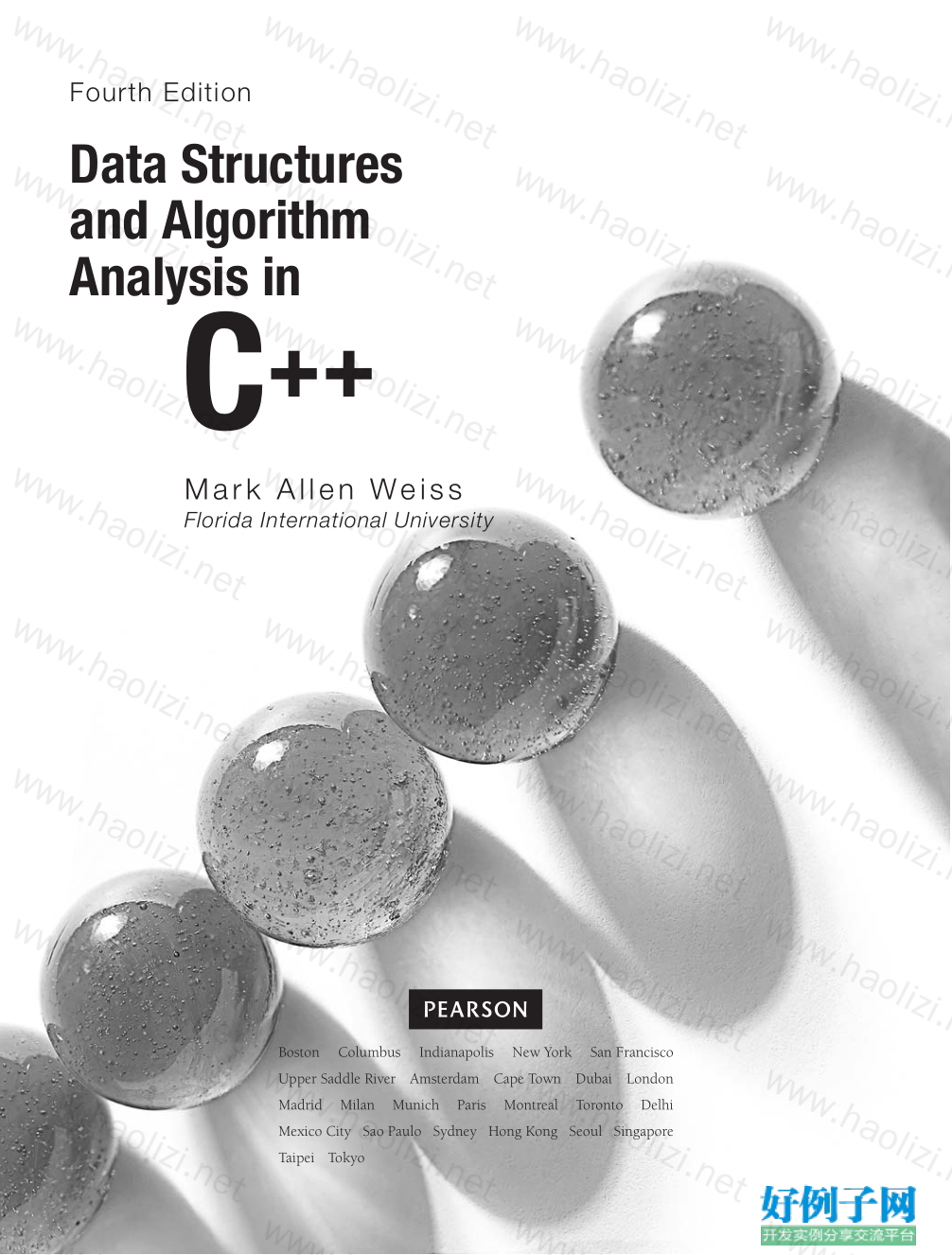
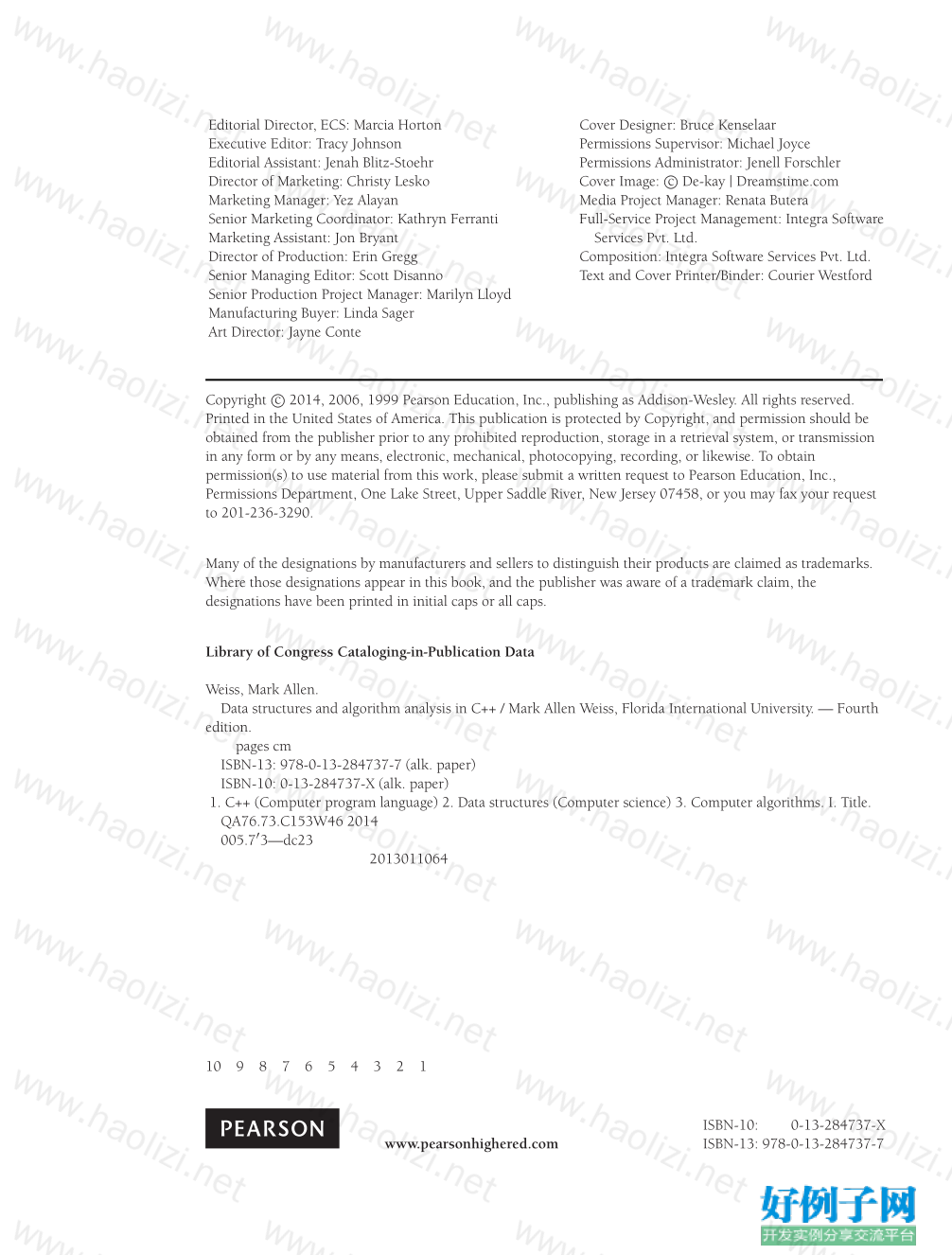
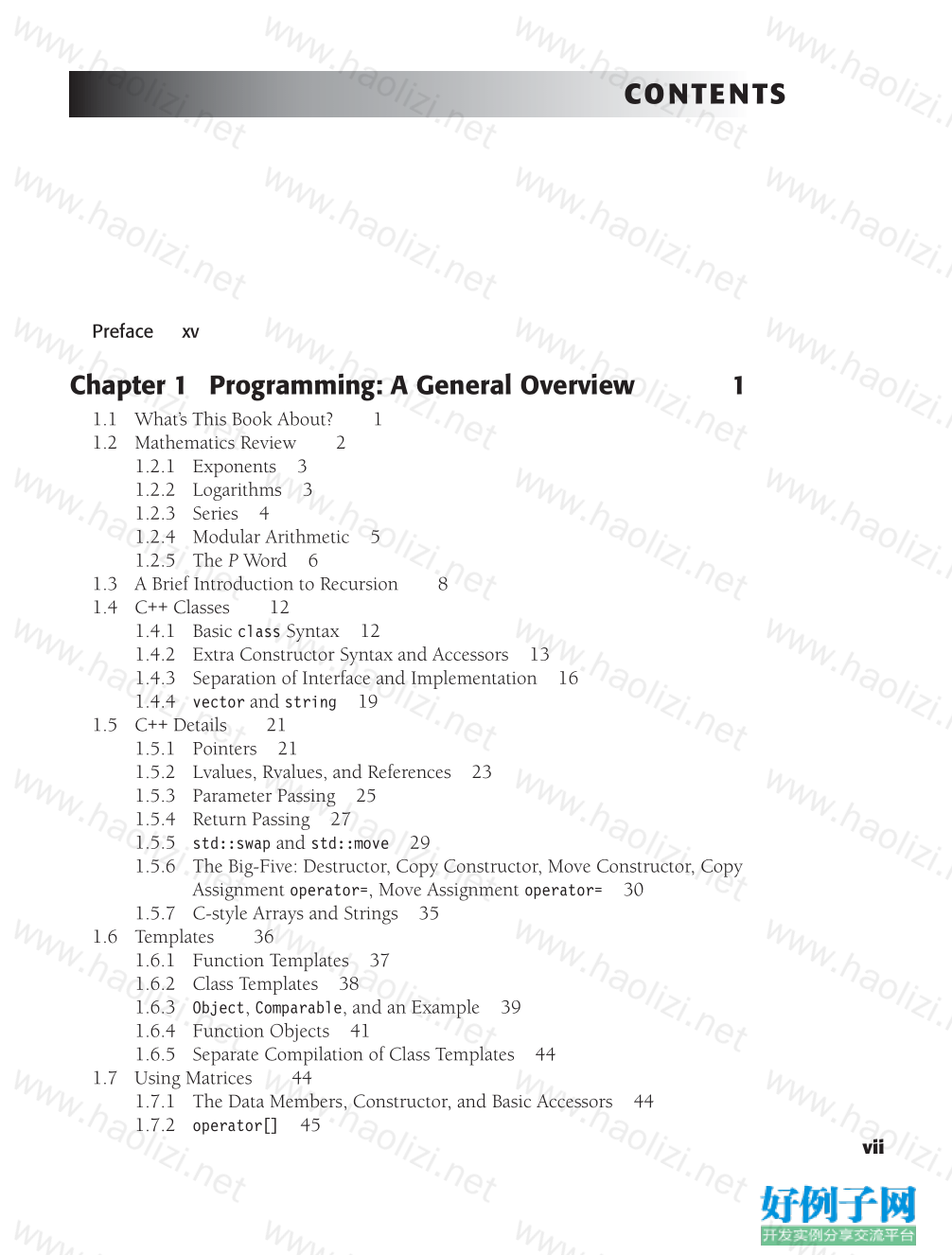
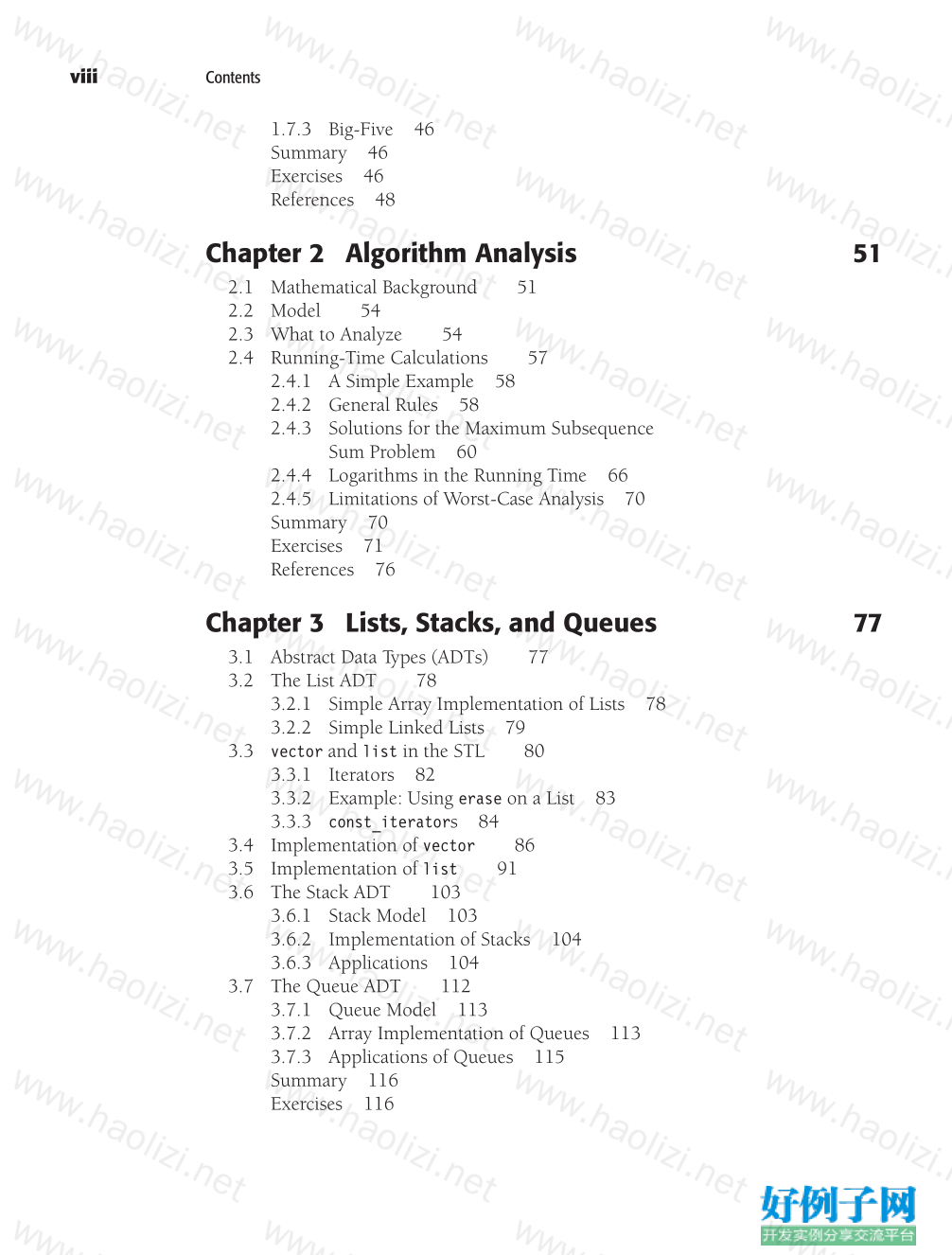
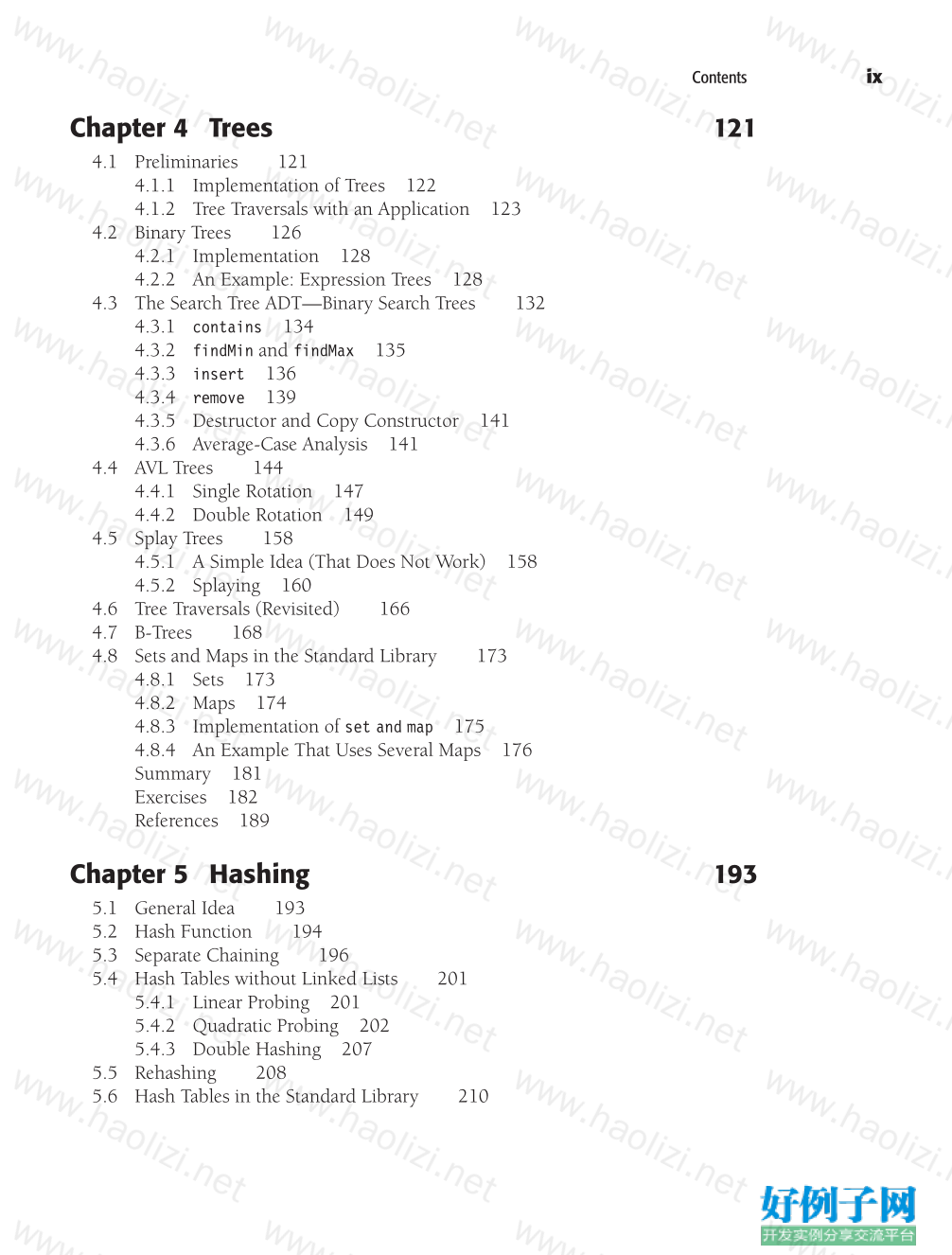
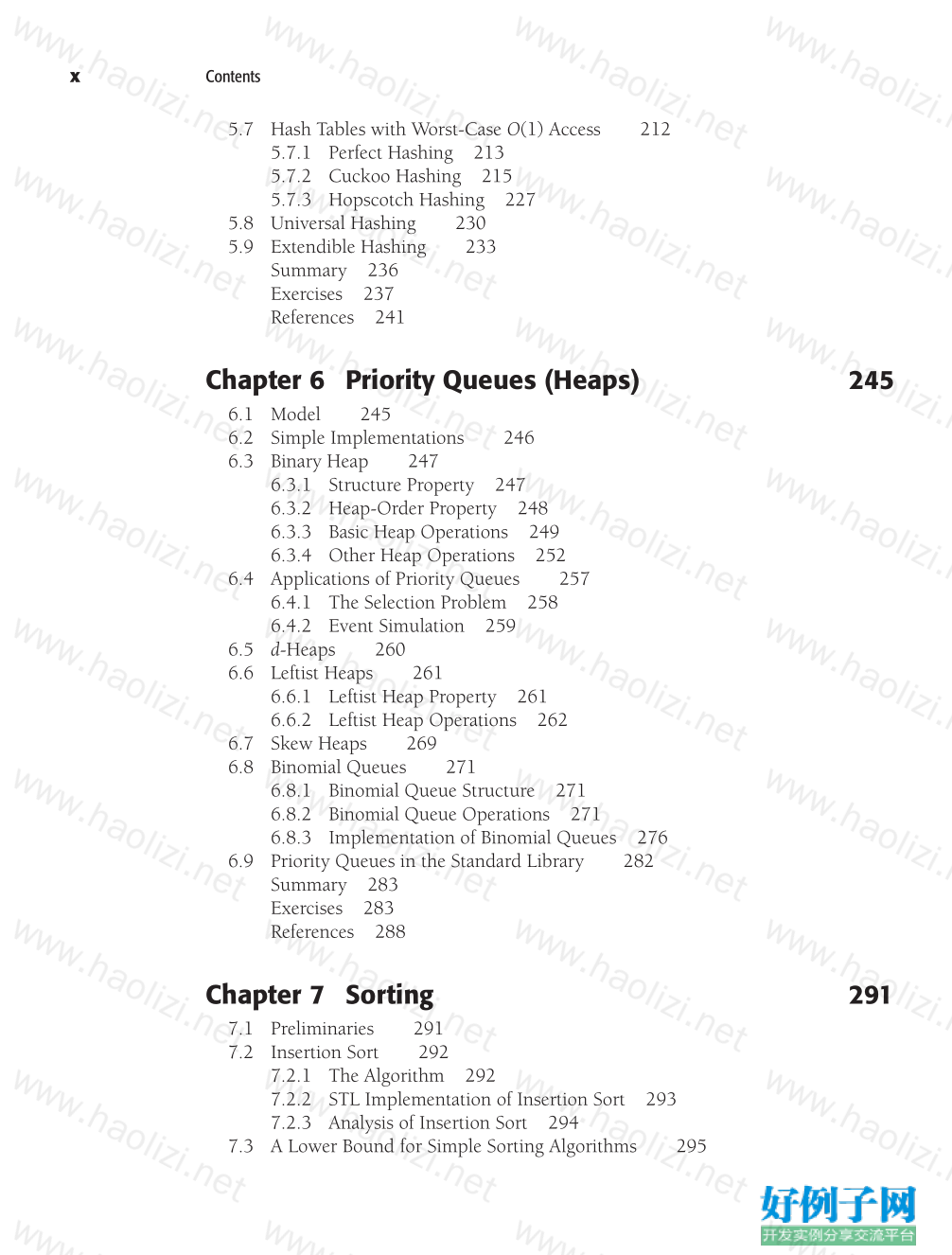
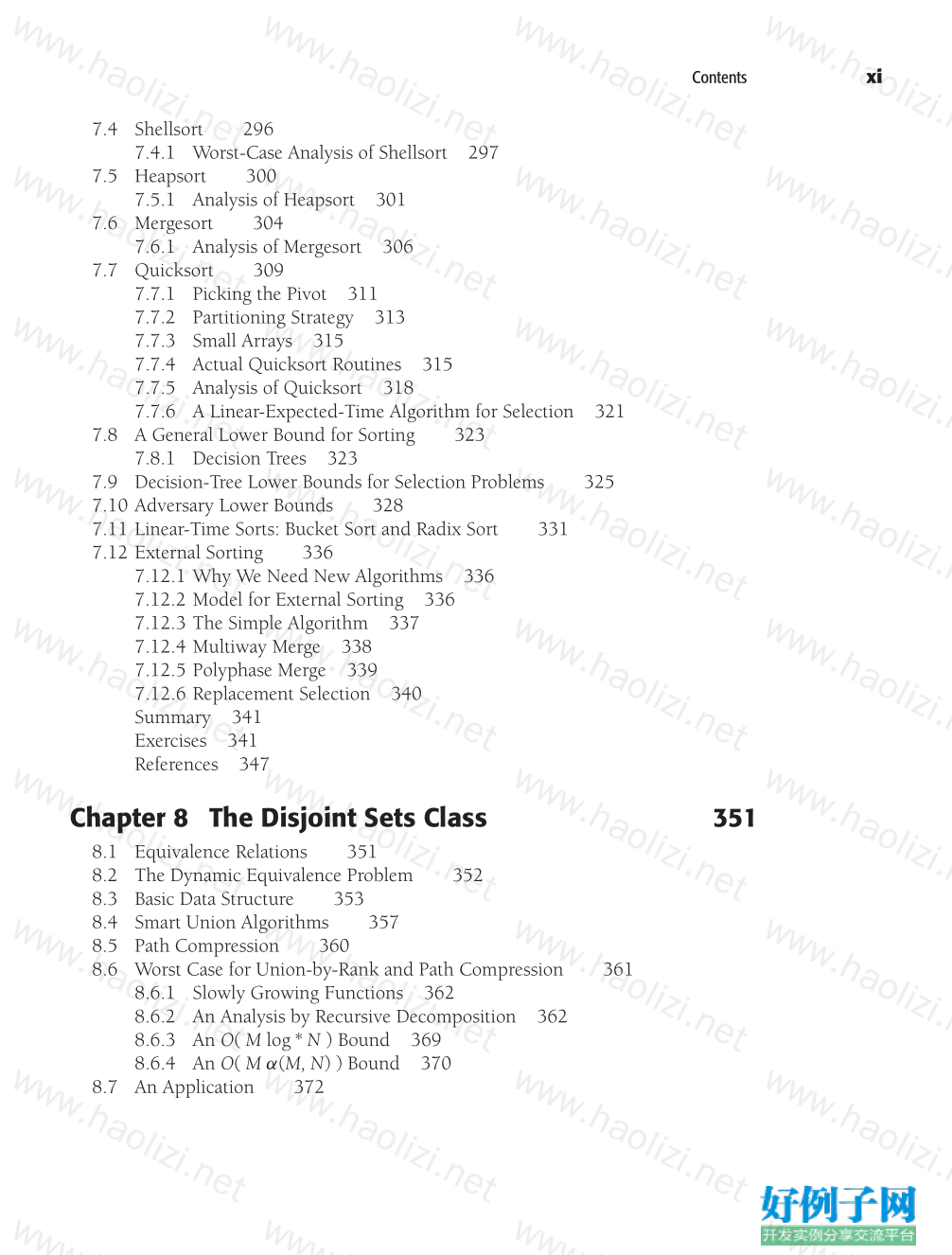

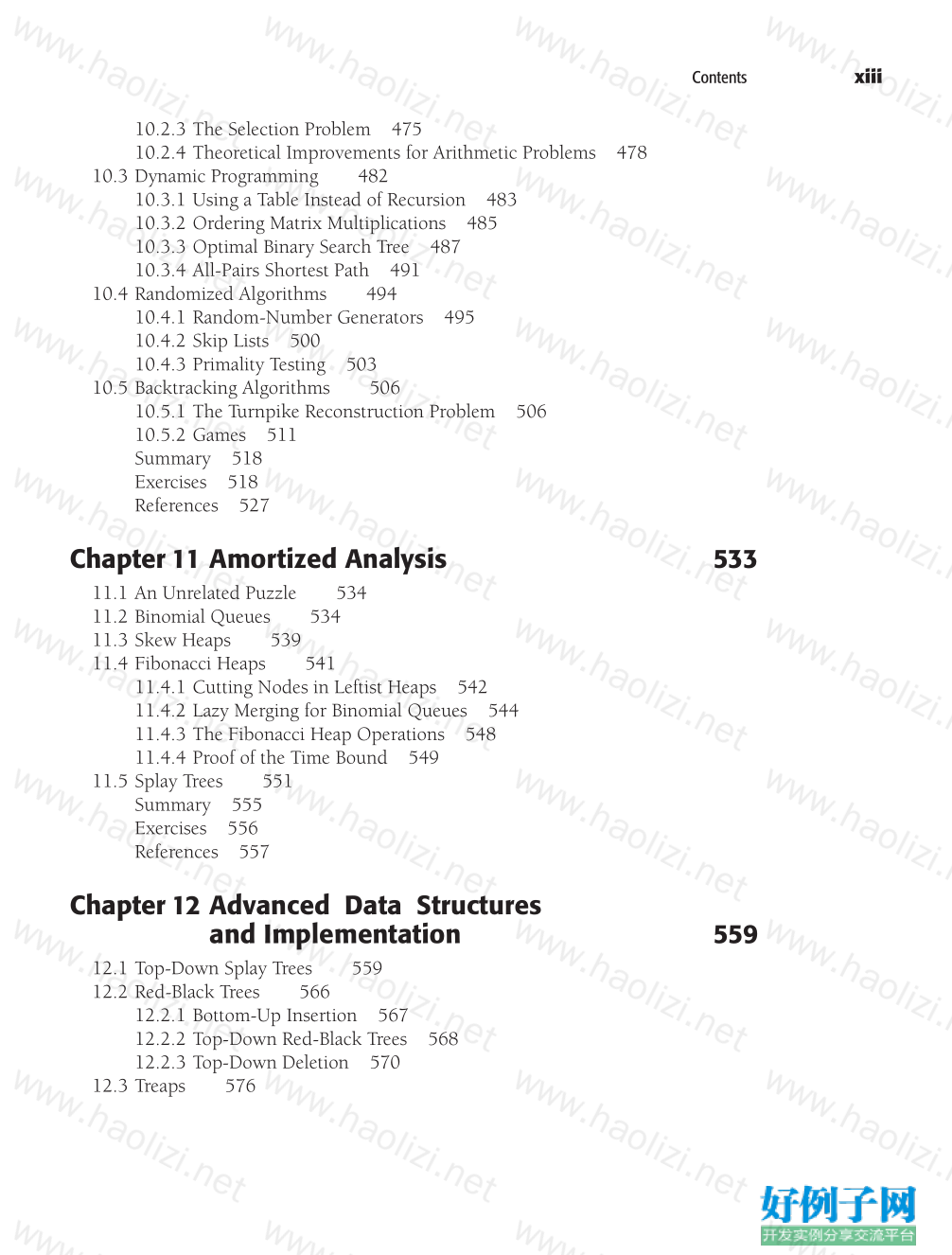
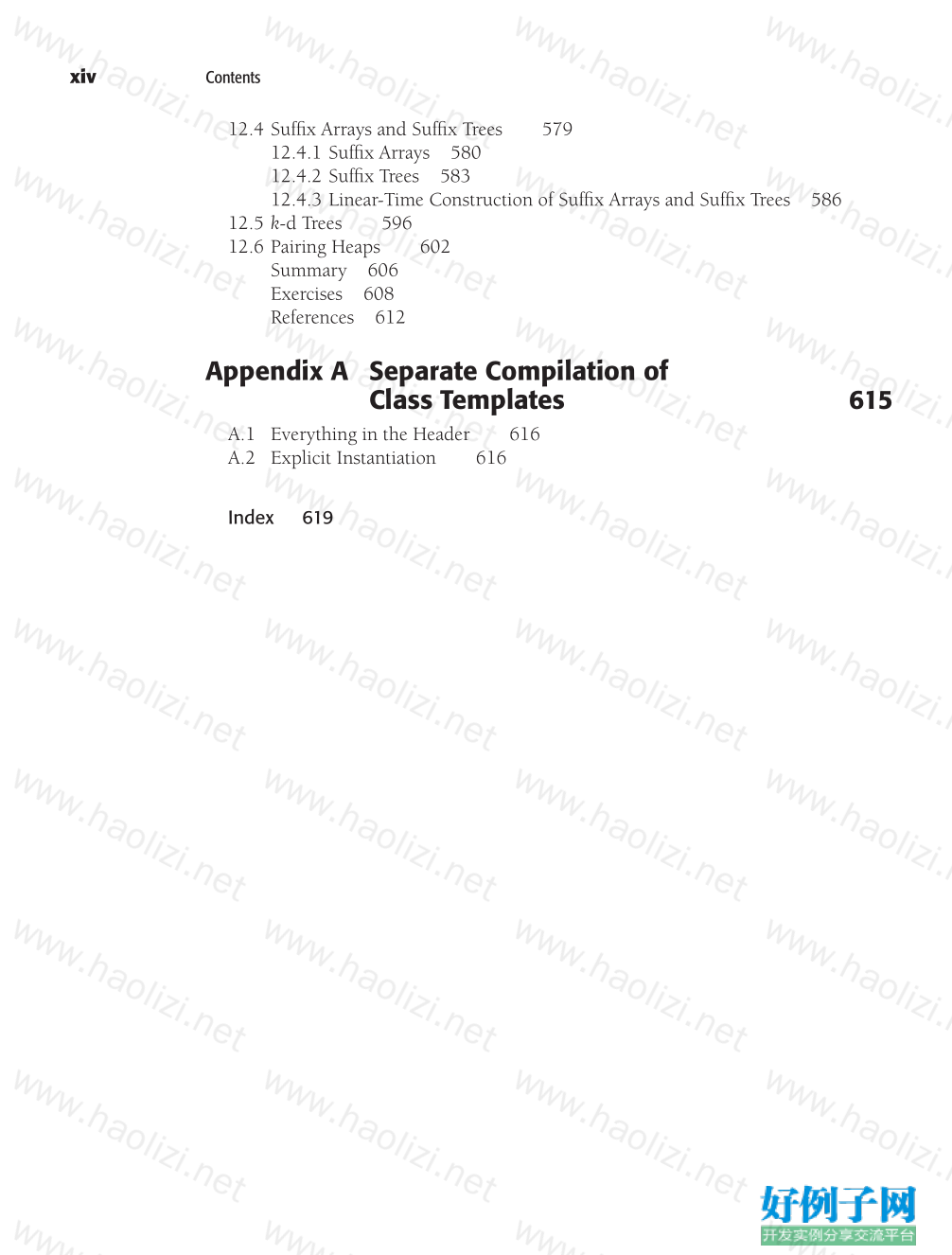
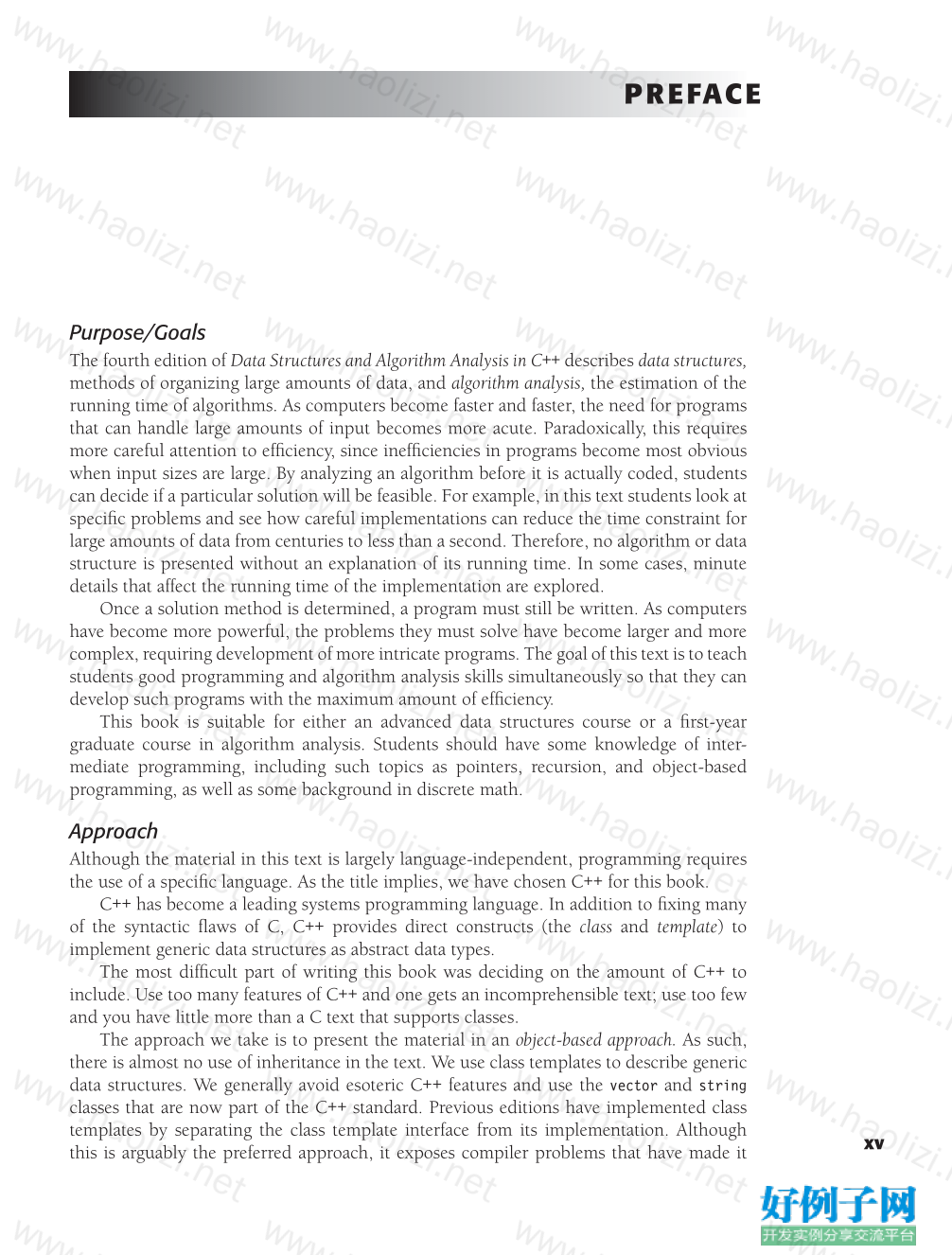
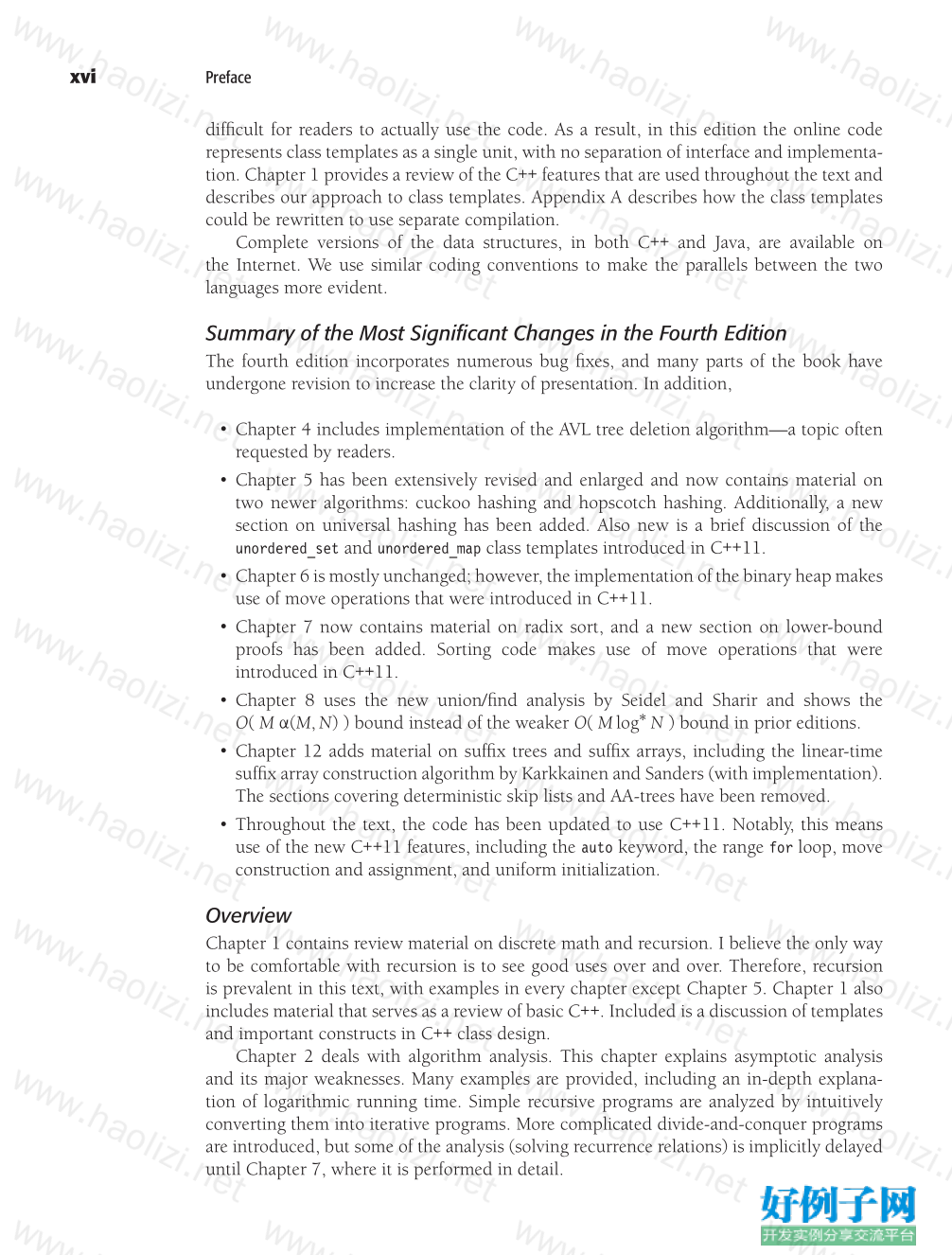
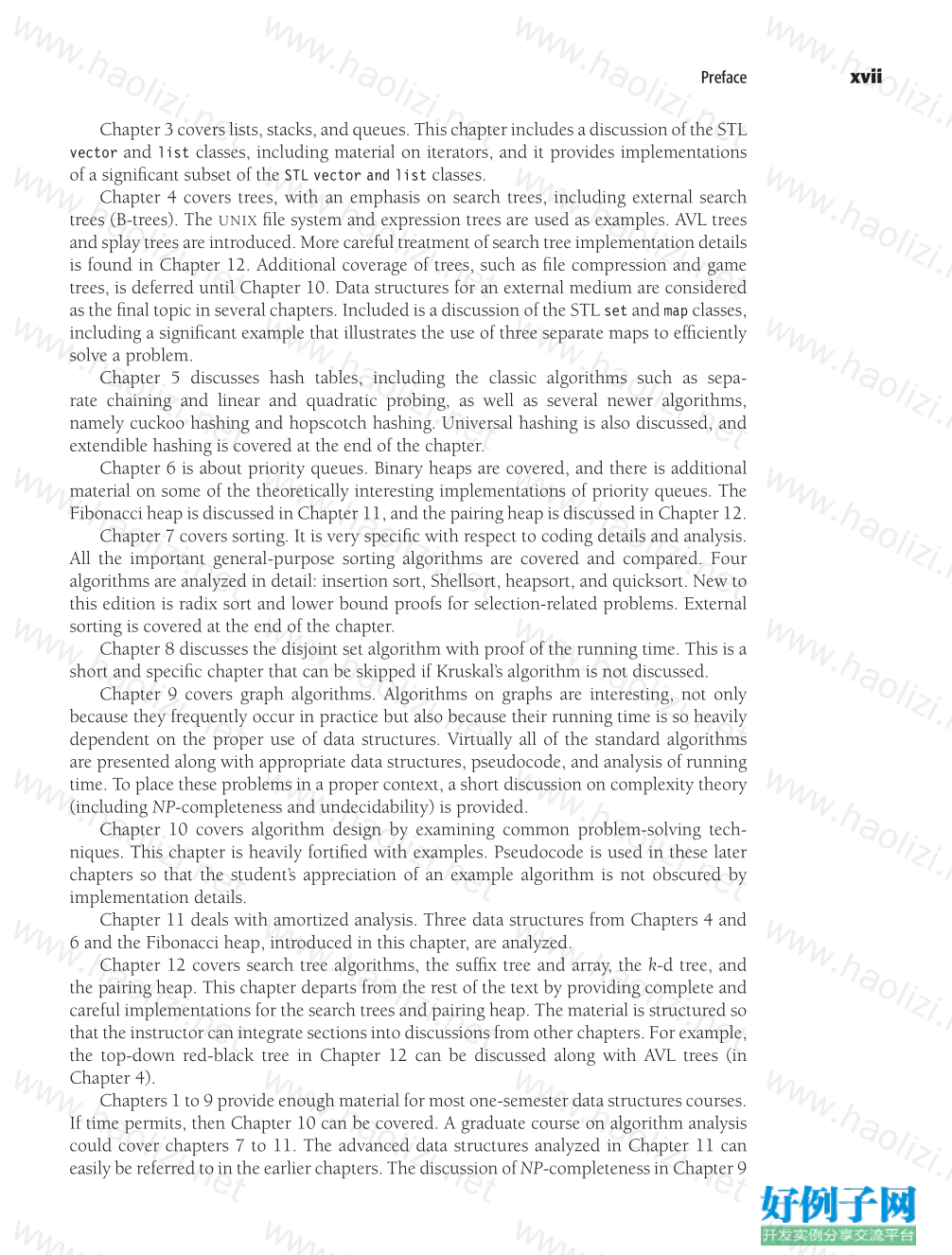
【核心代码】
Preface xv
Chapter 1 Programming: A General Overview 1
1.1 What’s This Book About? 1
1.2 Mathematics Review 2
1.2.1 Exponents 3
1.2.2 Logarithms 3
1.2.3 Series 4
1.2.4 Modular Arithmetic 5
1.2.5 The P Word 6
1.3 A Brief Introduction to Recursion 8
1.4 C Classes 12
1.4.1 Basic class Syntax 12
1.4.2 Extra Constructor Syntax and Accessors 13
1.4.3 Separation of Interface and Implementation 16
1.4.4 vector and string
19
1.5 C Details 21
1.5.1 Pointers 21
1.5.2 Lvalues, Rvalues, and References 23
1.5.3 Parameter Passing 25
1.5.4 Return Passing 27
1.5.5 std::swap and std::move
29
1.5.6 The Big-Five: Destructor, Copy Constructor, Move Constructor, Copy
Assignment operator=, Move Assignment operator=
30
1.5.7 C-style Arrays and Strings 35
1.6 Templates 36
1.6.1 Function Templates 37
1.6.2 Class Templates 38
1.6.3 Object, Comparable, and an Example 39
1.6.4 Function Objects 41
1.6.5 Separate Compilation of Class Templates 44
1.7 Using Matrices 44
1.7.1 The Data Members, Constructor, and Basic Accessors 44
1.7.2 operator[]
45
viiviii
Contents
1.7.3 Big-Five 46
Summary 46
Exercises 46
References 48
Chapter 2 Algorithm Analysis 51
2.1 Mathematical Background 51
2.2 Model 54
2.3 What to Analyze 54
2.4 Running-Time Calculations 57
2.4.1 A Simple Example 58
2.4.2 General Rules 58
2.4.3 Solutions for the Maximum Subsequence
Sum Problem 60
2.4.4 Logarithms in the Running Time 66
2.4.5 Limitations of Worst-Case Analysis 70
Summary 70
Exercises 71
References 76
Chapter 3 Lists, Stacks, and Queues 77
3.1 Abstract Data Types (ADTs) 77
3.2 The List ADT 78
3.2.1 Simple Array Implementation of Lists 78
3.2.2 Simple Linked Lists 79
3.3 vector and list in the STL 80
3.3.1 Iterators 82
3.3.2 Example: Using erase on a List 83
3.3.3 const_iterators 84
3.4 Implementation of vector
86
3.5 Implementation of list
91
3.6 The Stack ADT 103
3.6.1 Stack Model 103
3.6.2 Implementation of Stacks 104
3.6.3 Applications 104
3.7 The Queue ADT 112
3.7.1 Queue Model 113
3.7.2 Array Implementation of Queues 113
3.7.3 Applications of Queues 115
Summary 116
Exercises 116Contents
ix
Chapter 4 Trees 121
4.1 Preliminaries 121
4.1.1 Implementation of Trees 122
4.1.2 Tree Traversals with an Application 123
4.2 Binary Trees 126
4.2.1 Implementation 128
4.2.2 An Example: Expression Trees 128
4.3 The Search Tree ADT—Binary Search Trees 132
4.3.1 contains
134
4.3.2 findMin and findMax
135
4.3.3 insert
136
4.3.4 remove
139
4.3.5 Destructor and Copy Constructor 141
4.3.6 Average-Case Analysis 141
4.4 AVL Trees 144
4.4.1 Single Rotation 147
4.4.2 Double Rotation 149
4.5 Splay Trees 158
4.5.1 A Simple Idea (That Does Not Work) 158
4.5.2 Splaying 160
4.6 Tree Traversals (Revisited) 166
4.7 B-Trees 168
4.8 Sets and Maps in the Standard Library 173
4.8.1 Sets 173
4.8.2 Maps 174
4.8.3 Implementation of set and map
175
4.8.4 An Example That Uses Several Maps 176
Summary 181
Exercises 182
References 189
Chapter 5 Hashing 193
5.1 General Idea 193
5.2 Hash Function 194
5.3 Separate Chaining 196
5.4 Hash Tables without Linked Lists 201
5.4.1 Linear Probing 201
5.4.2 Quadratic Probing 202
5.4.3 Double Hashing 207
5.5 Rehashing 208
5.6 Hash Tables in the Standard Library 210x
Contents
5.7 Hash Tables with Worst-Case O(1) Access 212
5.7.1 Perfect Hashing 213
5.7.2 Cuckoo Hashing 215
5.7.3 Hopscotch Hashing 227
5.8 Universal Hashing 230
5.9 Extendible Hashing 233
Summary 236
Exercises 237
References 241
Chapter 6 Priority Queues (Heaps) 245
6.1 Model 245
6.2 Simple Implementations 246
6.3 Binary Heap 247
6.3.1 Structure Property 247
6.3.2 Heap-Order Property 248
6.3.3 Basic Heap Operations 249
6.3.4 Other Heap Operations 252
6.4 Applications of Priority Queues 257
6.4.1 The Selection Problem 258
6.4.2 Event Simulation 259
6.5 d-Heaps 260
6.6 Leftist Heaps 261
6.6.1 Leftist Heap Property 261
6.6.2 Leftist Heap Operations 262
6.7 Skew Heaps 269
6.8 Binomial Queues 271
6.8.1 Binomial Queue Structure 271
6.8.2 Binomial Queue Operations 271
6.8.3 Implementation of Binomial Queues 276
6.9 Priority Queues in the Standard Library 282
Summary 283
Exercises 283
References 288
Chapter 7 Sorting 291
7.1 Preliminaries 291
7.2 Insertion Sort 292
7.2.1 The Algorithm 292
7.2.2 STL Implementation of Insertion Sort 293
7.2.3 Analysis of Insertion Sort 294
7.3 A Lower Bound for Simple Sorting Algorithms 295Contents
xi
7.4 Shellsort 296
7.4.1 Worst-Case Analysis of Shellsort 297
7.5 Heapsort 300
7.5.1 Analysis of Heapsort 301
7.6 Mergesort 304
7.6.1 Analysis of Mergesort 306
7.7 Quicksort 309
7.7.1 Picking the Pivot 311
7.7.2 Partitioning Strategy 313
7.7.3 Small Arrays 315
7.7.4 Actual Quicksort Routines 315
7.7.5 Analysis of Quicksort 318
7.7.6 A Linear-Expected-Time Algorithm for Selection 321
7.8 A General Lower Bound for Sorting 323
7.8.1 Decision Trees 323
7.9 Decision-Tree Lower Bounds for Selection Problems 325
7.10 Adversary Lower Bounds 328
7.11 Linear-Time Sorts: Bucket Sort and Radix Sort 331
7.12 External Sorting 336
7.12.1 Why We Need New Algorithms 336
7.12.2 Model for External Sorting 336
7.12.3 The Simple Algorithm 337
7.12.4 Multiway Merge 338
7.12.5 Polyphase Merge 339
7.12.6 Replacement Selection 340
Summary 341
Exercises 341
References 347
Chapter 8 The Disjoint Sets Class 351
8.1 Equivalence Relations 351
8.2 The Dynamic Equivalence Problem 352
8.3 Basic Data Structure 353
8.4 Smart Union Algorithms 357
8.5 Path Compression 360
8.6 Worst Case for Union-by-Rank and Path Compression 361
8.6.1 Slowly Growing Functions 362
8.6.2 An Analysis by Recursive Decomposition 362
8.6.3 An O( M log *N ) Bound 369
8.6.4 An O( M α(M, N) ) Bound 370
8.7 An Application 372xii
Contents
Summary 374
Exercises 375
References 376
Chapter 9 Graph Algorithms 379
9.1 Defifinitions 379
9.1.1 Representation of Graphs 380
9.2 Topological Sort 382
9.3 Shortest-Path Algorithms 386
9.3.1 Unweighted Shortest Paths 387
9.3.2 Dijkstra’s Algorithm 391
9.3.3 Graphs with Negative Edge Costs 400
9.3.4 Acyclic Graphs 400
9.3.5 All-Pairs Shortest Path 404
9.3.6 Shortest Path Example 404
9.4 Network Flow Problems 406
9.4.1 A Simple Maximum-Flow Algorithm 408
9.5 Minimum Spanning Tree 413
9.5.1 Prim’s Algorithm 414
9.5.2 Kruskal’s Algorithm 417
9.6 Applications of Depth-First Search 419
9.6.1 Undirected Graphs 420
9.6.2 Biconnectivity 421
9.6.3 Euler Circuits 425
9.6.4 Directed Graphs 429
9.6.5 Finding Strong Components 431
9.7 Introduction to NP-Completeness 432
9.7.1 Easy vs. Hard 433
9.7.2 The Class NP 434
9.7.3 NP-Complete Problems 434
Summary 437
Exercises 437
References 445
Chapter 10 Algorithm Design Techniques 449
10.1 Greedy Algorithms 449
10.1.1 A Simple Scheduling Problem 450
10.1.2 Huffman Codes 453
10.1.3 Approximate Bin Packing 459
10.2 Divide and Conquer 467
10.2.1 Running Time of Divide-and-Conquer Algorithms 468
10.2.2 Closest-Points Problem 470Contents
xiii
10.2.3 The Selection Problem 475
10.2.4 Theoretical Improvements for Arithmetic Problems 478
10.3 Dynamic Programming 482
10.3.1 Using a Table Instead of Recursion 483
10.3.2 Ordering Matrix Multiplications 485
10.3.3 Optimal Binary Search Tree 487
10.3.4 All-Pairs Shortest Path 491
10.4 Randomized Algorithms 494
10.4.1 Random-Number Generators 495
10.4.2 Skip Lists 500
10.4.3 Primality Testing 503
10.5 Backtracking Algorithms 506
10.5.1 The Turnpike Reconstruction Problem 506
10.5.2 Games 511
Summary 518
Exercises 518
References 527
Chapter 11 Amortized Analysis 533
11.1 An Unrelated Puzzle 534
11.2 Binomial Queues 534
11.3 Skew Heaps 539
11.4 Fibonacci Heaps 541
11.4.1 Cutting Nodes in Leftist Heaps 542
11.4.2 Lazy Merging for Binomial Queues 544
11.4.3 The Fibonacci Heap Operations 548
11.4.4 Proof of the Time Bound 549
11.5 Splay Trees 551
Summary 555
Exercises 556
References 557
Chapter 12 Advanced Data Structures
and Implementation 559
12.1 Top-Down Splay Trees 559
12.2 Red-Black Trees 566
12.2.1 Bottom-Up Insertion 567
12.2.2 Top-Down Red-Black Trees 568
12.2.3 Top-Down Deletion 570
12.3 Treaps 576xiv
Contents
12.4 Suffifix Arrays and Suffifix Trees 579
12.4.1 Suffifix Arrays 580
12.4.2 Suffifix Trees 583
12.4.3 Linear-Time Construction of Suffifix Arrays and Suffifix Trees 586
12.5 k-d Trees 596
12.6 Pairing Heaps 602
Summary 606
Exercises 608
References 612
Appendix A Separate Compilation of
Class Templates 615
A.1 Everything in the Header 616
A.2 Explicit Instantiation 616
Index 619
















网友评论
我要评论